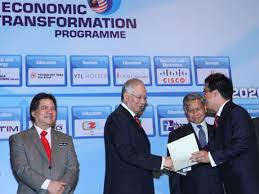A Kadir Jasin
THIS story is long. It may even be boring. But it is useful.
It is the story that we must know if we care about our today and, more
importantly, if we care about the tomorrows of our children and their children.
[REMINDER: No anonymous comments
will be published. Please use Google
Account, OpenID or Name/URL. Pseudonym is accepted. Be respectful. No swearing.
Thank you]
Those of us who have lived through economic crises that the
country had faced since independence would have been very worried by the
apparent lack of preparedness and clarity in the current round.
Although our economy is far from getting into recession, the
signs of impending stagnation are abundant. Since the Asian Economic crises of
1997/98, our economy has not been growing higher than 5% annually in contrast
to the plus 7% achieved before that.
While we have to accept the fact that GDP growth would slow
down and taper off as the economy matures, what worries us is the lack of
direction and preparedness in facing the economic crises.
Even the “celebrated” economic transformation plan (ETP),
the corner stone of Prime Minister (Datuk
Seri Mappadulung Daeng Mattimung Karaeng Sanrobone) Mohd Najib Abdul Razak’s economic
management appears to have failed to arrest the current decline, partly because
of the lack of confidence in his leadership.
 |
| Is there magic in Mohd Najib's ETP? |
Let me briefly outlined the various economic crises the
country had gone through and actions taken to overcome them. Readers are
invited to correct me as well as make this analysis more complete.
1. When we became independent in 1957, commodity prices were
high, buoyed by the demand for raw materials in the wake of the Korean War.
Those were the years when it was told that a Chinese shopkeeper could sell a
refrigerator to a Malay rubber tapper to store clothes. We were then a major
producer of rubber, tin, iron ore, timber and even gold.
2. The end of the Korean War saw prices of primary commodities
plunging. America started to release rubber and tin from its strategic
stockpile causing the price of rubber and tin to tumble.
3. This development cause hardship among rubber smallholders
and small tin miners, forcing young Malays and Chinese to migrate to big towns
and cities in search of jobs thus spawning illegal squatters’ colonies in and
around major centres like Kuala Lumpur and Penang. Urbanisation was accelerated
and the rural-urban drift gained pace.
4. The saving grace was jobs were available in the Klang
Valley, thanks to the industrialisation policy launched by the government in
the mid-1960s. Low paying jobs were abundant in the import-substitution
industries like timber, food manufacturing, textiles and other low technology.
5. But urbanisation had its good and bad sides. The
migrating Malays got job and more money that they ever had. The traders, the
majority of whom are Chinese, saw their businesses flourished. Also through the
process of commerce - the exchange of goods and services among the Malays and
Chinese - that the new migrants became aware of their economic backwardness.
6. The racial and religious provocations during the long
period of the 1969 General Election campaign boiled over in the aftermath of
May 10 poll in which the ruling Alliance party, the forerunner of the Barisan
Nasional, lost to the Chinese- and Islamist-led opposition parties. They
resulted in the bloody May 13 riots in Kuala Lumpur.
7. Led by Tun Dr Mahathir Mohamad, the thinkers among the
Malays identified economic disenfranchisement of the Malays as the underpinning
reason for the riots, resulting in the formation of a national unity government
led by the late Tun Abdul Razak Hussein in 1969 and the launch of the New
Economic Policy (NEP) in 1971.
8. Although it was widely criticised, the NEP succeeded in
eradicating poverty, which at the starting point was 49% and speeding up growth
but failed to achieve the 30% Bumiputra ownership of the corporate sector.
9. The first major economic crisis in the post-NEP era
happened soon after it was launched due to the global effect of the Arab oil
embargo in 1973. Coupled with low commodity prices, it caused major hardship to
the people. The crisis was dramatised by the Datuk Seri Anwar Ibrahim when he
led a protest in Baling in 1974. Although Anwar was incarcerated under
now-defunct ISA, several remedial policies were launched to assist rubber
smallholders such as accelerated replanting, price support and improving
educational facilities in the rural areas. That was also the period that saw
Malaysia taking active part in international commodity agreements and in global
trade arrangements.
10. Thanks largely to industrialisation, which by then had
entered the phase of export-oriented, and the rapid growth of the services
sector, our economy grew steadily until the mid-80s when it became overheated
and started to fail. It economy suffered negative growth for the first time in
history in 1985-86, which saw the appointment of little known
lawyer-turned-businessman Tun Daim Zainuddin as Finance Minister.
11. Daim launched an austerity drive that saw salaries of
Ministers and senior civil servants being cut, government expenditures
realigned and pre-paying government loans. Policies favouring the private
sector, including corporatisation and privatisation, were introduced. The
economy was successfully resuscitated and went on to grow briskly for a full
decade until the 1997/98 Asian Financial Crises.
12. It was during this decade of unprecedented growth that
Anwar successfully rode the waves to put himself within touch of the Prime
Minister’s job, partly by taking credit for the rapid growth of the economy.
13. Then in June/July 1997, one after another the currencies
of the South East Asian and East Asian countries came under speculative
attacks, causing almost all of them, with the exception of Singapore dollar, to
crash, taking with them the entire economy. Our economy went into recession.
14. The ready solution for most of these countries was to
resort to the bailout by the International Monetary Fund (IMF) – a method
favoured by Anwar but bluntly rejected by Dr Mahathir. Under protest from Anwar
and the free market economists, in September 1998 Dr Mahathir introduced the
limited exchange control, which among other things pegged the exchange rate of
the ringgit at RM3.80 to a dollar.
15. Dr Mahathir was condemned for his actions and the entire
financial world predicted that Malaysia would fail as a pariah state. Daim was
once again brought back to mend the economy. Within a year the economy went
back on a growth path but never again at the pace of the post-crisis period. In
2008, under Mohd Najib’s stewardship, the economy once again went into
recession due to the global effects of the US mortgage crisis.
6. In facing all the above crises our government had a plan
and invariably, due to the confidence the people and investors had in it,
solutions were found, implemented, monitored and finally, achieved their desire
result. Yes, there were hardships, business failures and unemployment but there
was always the light at the end of the tunnel.
17. With the above as the background, let us ask ourselves:
Do we now see the light at the end of the tunnel? Do we know what our
government is doing? Are we confident in what our government is doing? Are we
clear of the direction our country is heading?
18. If the answers to the above are in the positive, then
there are hopes for us, and our country. But should the answers be in the
negative, the future holds nothing but fear and uncertainty for us and our
beloved Malaysia.
Wallahuaklam.






















